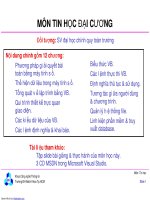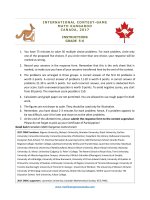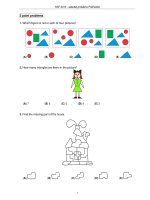trường thcs hoàng xuân hãn
Bạn đang xem bản rút gọn của tài liệu. Xem và tải ngay bản đầy đủ của tài liệu tại đây (33.43 KB, 1 trang )
<span class='text_page_counter'>(1)</span><div class='page_container' data-page=1>
<b>BRITISH COLUMBIA SECONDARY SCHOOL</b>
<b>MATHEMATICS CONTEST, 2008</b>
<b>Senior Final, Part B</b>
<b>Friday, May 2</b>
1. (a) Simplify the expression over a common denominator
1
<i>a</i>−1+
1
<i>a</i>+1
<i>for a</i>6=1.
(b) <i>If a is any real number with a</i>>1, use your result in part (a) to determine which is larger
1
<i>a</i>−1 +
1
<i>a</i>+1 or
2
<i>a</i>
(c) Use your answer in part (b) to determine which is larger
1
999999+
1
1000001 or
1
500000
2. (a) <i>Find the point(s) of intersection of the circle of radius a with centre at the point</i>(<i>0, a</i>)<i>on the y-axis</i>
<i>with the parabola y</i>=<i>x</i>2<sub>.</sub>
(b) <i>Find the radius of the largest circle with centre on the positive y-axis that intersects the parabola</i>
<i>y</i>=<i>x</i>2<sub>only at</sub><sub>(</sub><sub>0, 0</sub><sub>)</sub><sub>.</sub>
3. A census taker, who was very intelligent, came to a house where the three inhabitants were not at
home. A neighbour, who knew the inhabitants, was in the yard next door. The census taker already
knew the age of the neighbour. To determine the ages, as a whole number of years, of the
inhab-itants of the house, the census taker asked the neighbour the following questions and received the
corresponding replies:
Question: “What is the product of their ages?”
Reply: “252”
Question: “What is the sum of their ages?”
Reply: “The same as their house number.”
Question: “Are any of them older than you?”
Reply: “No.”
With that information the census taker wrote down the three ages. What are the ages of the inhabitants
of the house?
4. <i>The three sides of a triangle have lengths k,</i> 1
<i>k, and 2. Using a pair of inequalities of the form a</i><<i>k</i><<i>b,</i>
<i>describe the set of all possible values of k.</i>
5. <i>The shortest path on the surface of a cube from vertex A to the furthest</i>
<i>vertex B involves crossing a certain number of faces and edges of the cube.</i>
See the diagram.
<i>A</i>
<i>B</i>
(a) How many faces and how many edges must be crossed?
(b) <i>How many such shortest paths are there from vertex A to vertex B?</i>
(c) If we call the intersection of a shortest path with an edge a “corner”,
</div>
<!--links-->









